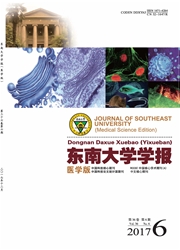

 中文摘要:
中文摘要:
目的:研究赖氨酸特异去甲基化酶1(LSD1)和赖氨酸去甲基化酶5家族(KDM5家族成员)在人卵巢癌细胞中的表达,分析LSD1对细胞增殖迁移的影响。方法:在3种卵巢癌细胞株中,分别用RT-PCR检测LSD1、KDM5A、KDM5B、KDM5C、KDM5D的mRNA的表达,蛋白质印迹法检测前4种酶的表达;在人正常卵巢上皮细胞和癌细胞株中,采用蛋白质印迹法检测LSD1的表达;用MTT法检测LSD1对卵巢癌细胞株增殖的影响;应用划痕试验检测LSD1对卵巢癌细胞株迁移的影响。结果:在3种人卵巢癌细胞的上述5种酶中,LSD1表达水平最高(P〈0.01),KDM5家族成员在不同细胞系中差异表达。LSD1抑制剂反苯环丙胺处理卵巢癌细胞后,用MTT法发现抑制LSD1能显著降低癌细胞增殖(P〈0.05),刮痕实验发现该药物可显著抑制卵巢癌细胞的迁移(P〈0.05)。结论:LSD1在卵巢癌中高表达,KDM5家族差异化表达;LSD1与卵巢癌细胞系的增殖和迁移能力密切相关。
 英文摘要:
英文摘要:
Objective: To investigate the expression of lysine-specific demethylase 1( LSD1) and lysine demethylase 5( KDM5),as well as the role of LSD1 on proliferation and migration within human ovarian cancer cells. Methods: Relative mRNA and protein levels of LSD1,KDM5 A,KDM5B,KDM5 C,KDM5D were detected respectively by real-time quantitative and Western blot in SKOV-3,HO8910,3AO cells. The expressions of LSD1 were comparatively analyzed between a human ovarian epithelial cell line and three ovarian cancer cell lines by Western blot. In addition,the effects of LSD1 on proliferation and migration were determinted by MTT and woundhealing assay respectively. Results: The expression of LSD1 was highest( P〈0. 01),and the expression of KDM5 members was different in these ovarian cancer cells. Tranylcypromine, the inhibitor of LSD1, significantly decreased the proliferation and migration( P〈0. 05). Conclusion: LSD1 expresse at high level and the member of KDM5 family expresse at differentiated level within 3 ovarian cancer cell lines,and LSD1 is significantly correlated with the proliferation and migration within these 3 ovarian cancer cell lines.
 同期刊论文项目
同期刊论文项目
 同项目期刊论文
同项目期刊论文
 Role of the Hypoxia-inducible factor-1 alpha induced autophagy in the conversion of non-stem pancrea
Role of the Hypoxia-inducible factor-1 alpha induced autophagy in the conversion of non-stem pancrea 期刊信息
期刊信息
